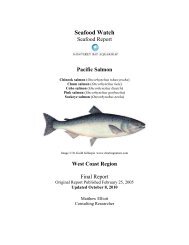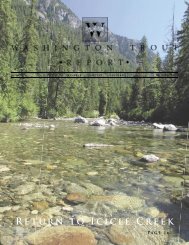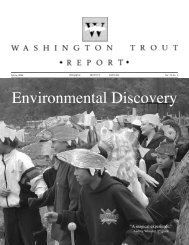Whidbey Island Near Shore Research Project
Washington Trout Report - Wild Fish Conservancy
Washington Trout Report - Wild Fish Conservancy
- No tags were found...
You also want an ePaper? Increase the reach of your titles
YUMPU automatically turns print PDFs into web optimized ePapers that Google loves.
GPS and survey equipment will be used to delineate<br />
shorelines and adjacent wetlands in order to ground-truth<br />
the computer modeling. The next step will be to refine<br />
the process – comparing the GIS results to the field results<br />
and writing up the findings to provide a tool for local<br />
municipalities statewide as they update their shoreline<br />
master plans.<br />
Dale Russell, Washington Trout Field Technician, measures the height of<br />
a natural bedrock waterfall during a watertyping survey on Orcas <strong>Island</strong><br />
in San Juan County.<br />
The projects have been funded by a variety of<br />
sources, ranging from County and City governments,<br />
private foundations, Native American tribes, non-profit<br />
organizations, and the State’s Salmon Recovery Funding<br />
Board.<br />
The fundamental data that we collect about the<br />
distribution of fish and fish habitats assist regulatory<br />
agencies charged with planning responsible growth<br />
while protecting the community’s sensitive natural<br />
areas. While the preservation and recovery of our native<br />
fishes is furthered by habitat restoration projects, it is<br />
equally important to ensure that streams are protected<br />
from compromise in the first place. This can best be<br />
accomplished if local governments and other regulatory<br />
agencies have available the most accurate and current<br />
information with which to make their management<br />
decisions.<br />
Peter Bahls of the Northwest Watershed Institute<br />
(NWI) started investigating this issue several years ago<br />
while working in Jefferson County. Oftentimes he would<br />
get back from the field and calculate the area of a water<br />
body using maps and graph paper, and find that the surface<br />
water acreage of a lake that was not on the state list<br />
qualified as a <strong>Shore</strong>line of the State. He then contacted the<br />
Department of Ecology, the state agency responsible for<br />
enforcing the <strong>Shore</strong>line Management Act. Biologists who<br />
specialize in shoreline determination from the Department<br />
of Ecology joined Peter and confirmed that many of the<br />
lakes that were not on the State list met the criteria of a<br />
<strong>Shore</strong>line of the State. Ecology had been aware of the<br />
issue, but did not have the resources to look into and fix<br />
the problem for the entire state. Meanwhile development<br />
was, and still is, affecting lakes like this one all over<br />
Washington.<br />
-- JG<br />
Lake Typing<br />
Washington Trout is trying to get lakes classified as,<br />
well, lakes! Under the <strong>Shore</strong>line Management Act, bodies<br />
of water with a surface area greater than 20 acres should be<br />
classified as lakes. But too often these natural resources are<br />
overlooked and/or misclassified, denied the protection they<br />
are entitled to by law; we are trying to change that.<br />
<strong>Shore</strong>lines of lakes in Washington are designated as<br />
“shorelines of the state” based on whether or not the lake<br />
has a surface area greater than 20 acres. This designation<br />
puts special protections on the body of water. Under an<br />
EPA grant, Washington Trout and the Northwest Watershed<br />
Institute are developing a methodology for determining<br />
lake size using Geographical Information System (GIS)<br />
analysis of aerial photos. Following the GIS analysis,<br />
How did it get this way? Currently Washington lists<br />
only 200 bodies of water as being 20 acres or greater in<br />
their statewide inventory. The State adopted this inventory<br />
in 1973 from a book, Lakes of Washington, which<br />
unfortunately does not explain how the sizes of the water<br />
bodies were calculated.<br />
The Department of Ecology now has biologists that<br />
specialize in shoreline determination. Using the state’s<br />
legal definition of a lake, these biologists determine the<br />
ordinary high water mark (the legal shoreline), which can<br />
include adjacent wetlands that are dry most of the year. WT<br />
26






